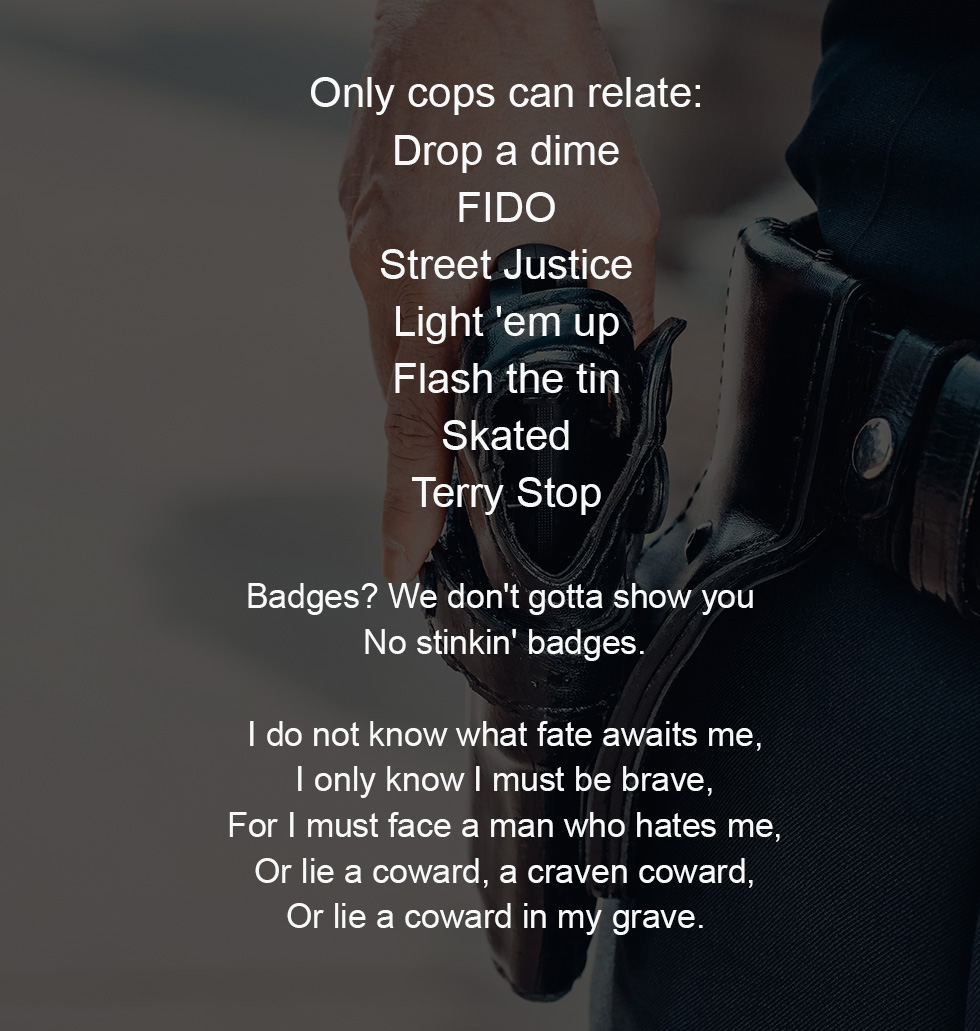Preface
The below off-duty firearms carry survey, though not comprehensive, provides a window into the thinking of major police agencies including American federal, county and city plus the positions of two foreign national agencies. The subject here is not about being able to protect yourself, per se, but more about being in position of being able to protect those you’ve sworn to serve and protect. The oath American LEOs take doesn’t say: while on-duty only. Thus, if any LEO who doesn’t wish to protect him/herself and family while off-duty is a personal choice, in public, the obligation to protect others is mandatory.
History
A few decades ago some courts ruled that LEOs could not carry off-duty unless so ordered by their department and as part of their official capacity. This led to Chiefs making it formal policy that all officers must carry while off-duty. Contracts, unions and the FOP interpreted that to mean officers should be paid for being on-call. Legislatures intervened and cops, for the most part, were “allowed” to carry off-duty. Policies, laws and practices change over time. [1]
When it comes to carrying off-duty firearms, there are three types of police officers: One that always carries a handgun and the one that never carries or one that sometimes carries. It’s a given that being an LEO involves far more danger than that of any other profession. As a cop, even when off-duty, running into a disgruntled past arrestee could generate a physical attack on you – or the family members you might be with at the time. The OIC at the Norwood, Ohio Police Academy, in response to a recruit’s question of should cops carry off-duty, said it best; Known as Umbaugh’s Law:
“One either never carries a firearm,
or one always carries,
but one never sometimes carries.” [2]
In other words, if your mindset is that you are carrying, then you won’t be transmitting unintentional vibes of fear; it naturally forces you to be in condition yellow at all times – aware of your surroundings. This personal persona of confidence is telegraphed by your posture, and the ability to look anyone in the eye with conviction. That shield in your pocket is far less protection against a homicidal maniac than a 9mm concealed on your hip.
Cops, per se, have that 6th sense, [3] the innate ability to “read people” – demeanors that include fear, strength, tuned-out/unaware, ready to attack/flee…. These attributes are also ofttimes discernable by criminals with animal-type instincts. In other words, there are bad guys that can read us too. Those who carry the power of life or death on their person, tend to transmit a self-preservation bearing. It’s a subconscious transmitting of alertness – a level of self-preservation and passive/aggressive identity.
When I moved to the downtown portion of Cincinnati, as a civilian and after 17 years of country living, I was saved by my projected image. On a warm summer evening, I decided to walk to my son’s home, about 8-10 blocks away. What I didn’t realize was my course took me through a high-crime neighborhood – one where tennis shoes hung from telephone and cable wires. The streets were lined with dilapidated rowhouses with only a narrow sidewalk between them and the curb. I was outfitted in shorts and a loose-fitting, short-sleeve shirt covering a Colt Diamondback in a strongside holster.
Sensing this route was not a good plan, I stuck to the middle of the, garbage-strewn street. Approaching a cluster of drug-seller types, dressed in underwear-exposing garb, I looked them over – eye-to-eye while eyeing possible barriers to use for defense. One of the gang-bangers stepped away from the group, smiled, showing a diamond studded tooth, and said, “What’s shakin’, officer.” Without breaking stride, I returned the smile while putting a finger to my lips in the classic “shhh” expression. I was no longer an LEO, but I’m convinced my character projected plain-clothed/undercover cop and that was enough to keep them at bay. I don’t believe I could have pulled that off sans the Colt. Looking tough, but knowing there is no gun available can sometimes be discerned by street-smart thugs who also have a 6th sense. My son drove me home later, using a different set of streets.
Possible advantages to never off-duty carry are not having to worry about being in a place that forbids possession of a lethal weapon – such as boarding a plane or when consuming alcoholic beverages. Of course, if you’re in condition yellow, you’ll be aware of these restricted locations. The third type of law officer, the sometimes carrier, creates a conflict inasmuch as pretending toughness or inadvertently walking into a restricted location while armed, and, of course, reaching for a gun when needed, but isn’t there. Even in your own castle, it is best to always carry, not only for the actual protection, but because it keeps you mindful that this power to protect is right where it should be. Besides, no one including your child, can get to it – if secure on your body. [4] Other than statutory restrictions, there is only one condition when one should never have a firearm on their person (or very close at hand) – when under the influence of anything that may impair thinking. You can’t teach common sense anymore you can fix stupid.
Worst Case Scenarios
a) You strap on your duty weapon, go about a daily routine, come home, store your gun and then … a past-target crashes thru the front door while the firearm is … stored. Or, you forgot to pick-up the milk on the way home and slip out, with a young daughter in tow for a quick run to the local stop & rob, sans a gun. “It’s just a short trip, honey – we’ll be right back”. At the S&R you walk into a robbery/mass shooting in-progress where the robber/shooter is coming after you and your child….
b) Suppose during normal waking hours, there’s an innocent knock at the front door – by a person in normal attire or dressed like an ordinary delivery driver? The threat, who pushes the door open as he/she intrudes, has the advantage. Doing anything other than draw, point (and fire if necessary), places defender under the control of the invader. In other words, to be prepared to protect yourself and the occupants of your home, the best place for your defensive handgun is on your person. And, it should be there every waking moment, no exceptions, no excuses. Besides, that’s the safest place if you have children.
c) You and the family are watching TV or sitting at the kitchen table when the door is suddenly and violently kicked in by the dude you arrested yesterday, last week… what are you gonna do … holler “kings,” “times” or “Hey, no fair fellas, let me get my gat?”
The Survey
In preparation for this article, select law enforcement agencies were contacted to learn of their guidelines for off-duty carry. Here are some of the results of correspondence regarding off-duty carry:
BUREAU OF ALCOHOL, TOBACCO, FIREARMS AND EXPLOSIVES:
“As sworn law enforcement officers, ATF special agents are generally authorized to carry ATF-approved firearms at all times.” (5)
THE ROYAL CANADIAN MOUNTED POLICE:
“RCMP officers may be permitted to carry firearms, while off-duty with permission of the CO. Permission is based on operational necessity only, e.g. a situation in which there is reason to believe that the life or safety of the member or other persons may be in imminent danger. While RMs are acting in the lawful course of their duties under RCMP Act, section 18, they are legally permitted to carry intervention options, including firearms….” [6]
FEDERAL BUREAU OF INVESTIGATION
“SA’s [Special Agents] are authorized and encouraged to be armed while ‘off duty.’” [7]
CINCINNATI POLICE DEPARTMENT
“Cincinnati Police Officers are allowed to carry firearms off duty. The carrying of a firearm off duty is not required. Cincinnati Police Officers must carry a firearm while attending court. If they carry a firearm, it must be approved by the Police Chief and the Range Master. The firearm must be 9mm Smith & Wesson 2.0 full size or Smith and Wesson M & P Compact 9mm
“Off-duty handguns provide officers with an alternative to carrying the primary duty weapon while off-duty. Carrying an off-duty handgun is optional, and will not be carried unless approved by the FTS. An officer who carries an off-duty handgun is responsible for its purchase, cost of repairs, maintenance, and ammunition. Officers must annually complete an Ohio Peace Officer Training Academy approved qualification course with their off-duty handgun. The FTS will conduct training sessions on a quarterly basis for officers wishing to carry an off-duty handgun.
“In the State of Ohio (effective June 2022) anyone over the age of 21 can open or concealed carry a pistol or revolver if they are eligible to carry such weapon and are not under disability by law. Our officers are allowed to do this, but not under our definition of off duty. Most either carry Off Duty Status or have a CCW. Some also go by the open or concealed carry provision”.
CPD Procedure Manual:
1. Carrying a firearm off-duty is optional.
2. Off-duty officers, not in uniform, who choose to carry a firearm, will conceal the firearm on their person.
3. An officer wishing to carry an off-duty handgun not listed in Sections A. 1, 3, and 4 must contact FTS for approval. a. If approved, the officer must qualify with the off-duty weapon.
4. Ohio Revised Code (ORC) 2923.15 prohibits carrying firearms while under the influence of alcohol or any drug of abuse. a. Law enforcement officers are not exempt from the prohibition.
5. The following ORC Sections apply to off-duty personnel, UNLESS they are acting in the scope of their duties as a police officer. a. ORC Section 2923.12.1, Illegal Possession of Firearm in Liquor Permit Premises. b. ORC Section 2923.12.2, Illegal Conveyance or Possession of Deadly Weapon or Dangerous Ordnance or Illegal Possession of Object Indistinguishable from Firearm in School Safety Zone. c. ORC Section 2923.12.3, Illegal Conveyance of Deadly Weapon or Dangerous Ordnance into Courthouse: Illegal Possession or Control in Courthouse.
6. Off-duty personnel may carry the Department authorized firearms listed in Sections A. 1, 3, and 4 of this procedure, after completing the approval process in Section F. H. Approval Process for Carrying a Personally Owned Department authorized firearm in an On or Off-Duty Status. All officers responding to court in civilian attire shall carry an authorized weapon concealed on their person in a secured holster. [8]
GERMAN FEDERAL CRIMINAL POLICE
“In accordance with section 55 (1), sentence 2 of the Weapons Act, in conjunction with the relevant service regulation, police officers of the Bundeskriminalamt (BKA), who have acquired the qualification for their service careers, are, in principle, authorized to carry officially licensed weapons (pistols or revolvers) and ammunition even when off duty.
“When the officer is off duty, he must carry the firearm in a concealed manner and also carry along his police ID card, which shows his right to carry a firearm. The authorization for off-duty handling of firearms does not apply when safe handling is not guaranteed. Long guns, flare pistols, service weapons, which are subject to the War Weapons Control Act, and firearms the shape of which is such that they can pass for another object or can be disguised as or are built into everyday items are expressly exempt from this.
“Pursuant to section 30 of the Basic Law for the Federal Republic of Germany, police matters fundamentally fall within the competence of the individual Länder (federal states); thus, the organization, tasks and powers of the police are regulated by the police laws of the Länder and regulations on the use of service weapons when off duty may differ from the provisions applicable to the BKA.” [9]
LOS ANGELES, CA SHERIFF’S DEPARTMENT Manual of Police and Procedures MPP 3-03/210.05 Firearms:
Any approved off-duty, back-up, or plainclothes handgun must comply with the following requirements:
Any handgun approved for on-duty use may be carried for off-duty, back-up, or plainclothes duty. Handguns equipped with a manual safety device must be carried on ‘Safe.’ Sworn Personnel must comply with all provisions of MPP 3-03/210.05. Handguns must be carried in a holster which covers the trigger guard (MPP 3-03/280.00). Unless stated otherwise, all firearms require a separate training and qualification course for certification to carry. Handguns with ported or compensated barrels are prohibited. .380 caliber handguns may be carried off-duty or as a back-up, but not as a primary on-duty handgun either in uniform or plain clothes when in positions requiring the carry of a firearm.
Sworn members (on-duty or off-duty, while in uniform or plain clothes) carrying any Department-authorized back-up or off-duty handgun, as a secondary handgun, must securely carry the weapon concealed from view. In no case shall it be carried on the duty belt or exposed in any way.
Department members shall carry any authorized semi-automatic handgun used on-duty, off-duty or as a secondary weapon in the following manner:
Loaded, with a round in the chamber;
* Magazine loaded to the magazine manufacturer’s specified capacity;
* Hammer of a single action pistol cocked (i.e., 1911 pistols);
* External hammer of a double action pistol de-cocked; and
* External safety in the on position, if equipped.
* Sworn members shall carry any authorized revolver used off-duty or as a secondary weapon with the cylinder loaded to capacity and hammer de-cocked (double action).
“LASD does not maintain any rule or policy mandating a ‘shall carry’ policy for carrying off duty.” [10]
Solutions
In as much as LEOs take an oath to serve and protect the public, coupled with the increasing number of mass-shooter incidents, local, county, state and federal police agencies might consider:
1) Requiring all sworn personnel to carry a handgun at all times – on-duty as well as off-duty. Though such a mandate might require financial incentives; the cost being offset by having to replace an officer who is gunned down who wasn’t carrying a firearm while off-duty. In addition, saving lives of those exposed to killers is a cost-effective method of complying with the obligation to serve and protect.
2) Officially and publicly encouraging their officers to carry off-duty. Such a policy, made public, will send a message that the agency takes protecting the public (and its officers) serious.
3) Foster the concept that the safest and most defensive-effective location for a handgun is on one’s person.
Summary
Though most LE agencies do not require their sworn personnel to carry a firearm while off-duty, perhaps it might be time to consider a change in policy. The benefits to society and law enforcement, specifically of sworn and trained personnel to carry a defensive handgun, should be obvious. Laws restricting carrying firearms by civilians will apply to all LEOs when they are no longer employed as cops and become an ordinary citizen once they leave the force. Of course, American federal law allows retired LEOs to carry, but that does not apply if they resign prior to retirement or their department’s qualification becomes burdensome due to retired officer’s relocation and/or abilities? It is most prudent to be armed at all times – even at home – where home invasion scenarios include “crazies” that pick a home at random, target a specific LEO or mistake their home as that of a stockpiling drug dealer.




